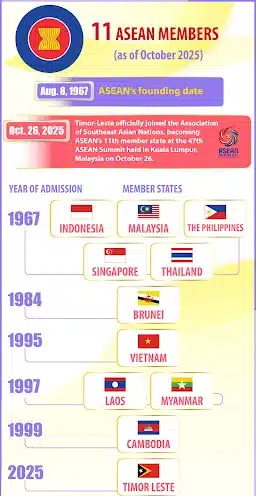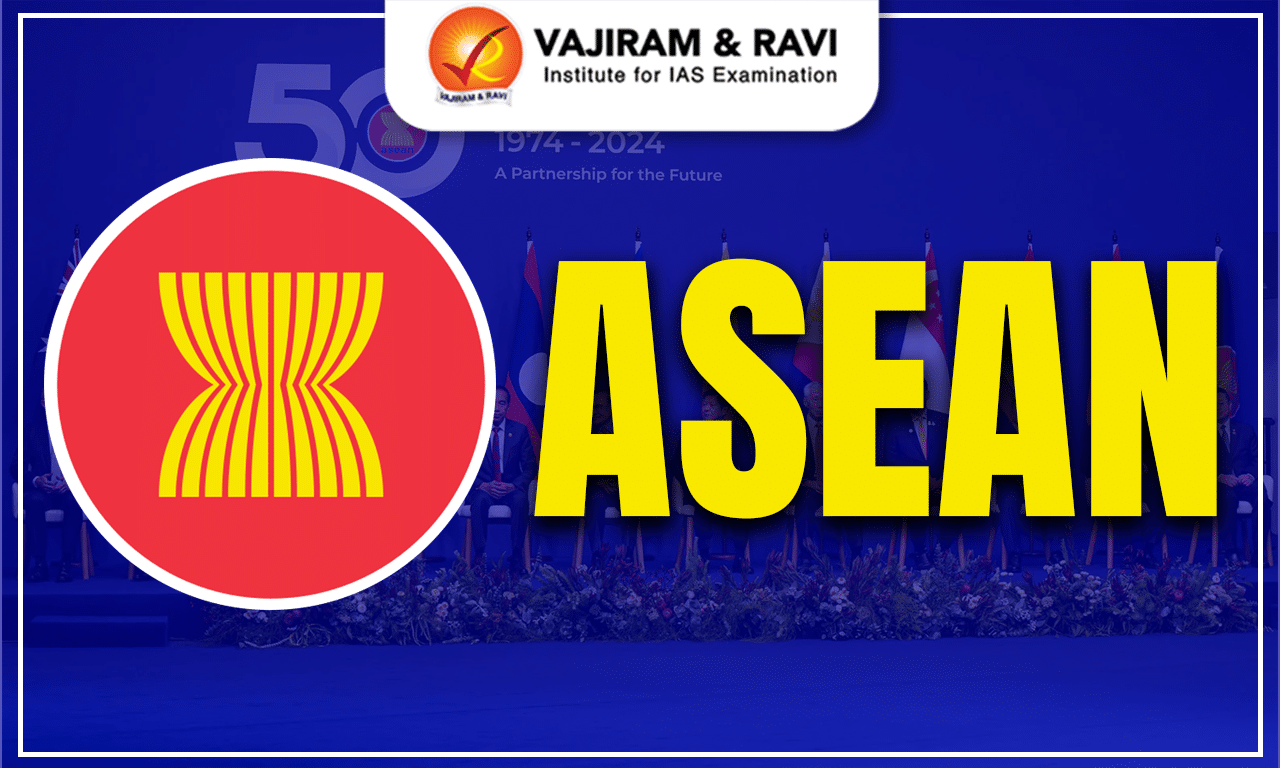The Association of Southeast Asian Nations (ASEAN) is a key regional organisation that promotes economic cooperation, political dialogue, and security collaboration among Southeast Asian countries. Established in 1967 with the signing of the Bangkok Declaration by Indonesia, Malaysia, the Philippines, Singapore, and Thailand, ASEAN has grown into a dynamic grouping of 11 members, including Brunei, Vietnam, Myanmar, Laos, Cambodia, and, most recently, Timor-Leste.
Guided by the motto “One Vision, One Identity, One Community,” ASEAN plays a central role in shaping the strategic and economic landscape of the Indo-Pacific region. With its strong economic potential, strategic location, and emphasis on regional peace and stability, ASEAN has emerged as an influential power in global affairs and a vital partner for India.
ASEAN About
The Association of Southeast Asian Nations (ASEAN) is a regional grouping that aims to promote economic and security cooperation among its members:
- ASEAN Formation: ASEAN was formed on 8 August 1967 in Bangkok, Thailand, with the signing of the ASEAN Declaration (Bangkok Declaration) by the founding members of ASEAN: Indonesia, Malaysia, the Philippines, Singapore and Thailand.
- Aim: The motto of ASEAN is “One Vision, One Identity, One Community”.
- ASEAN Members: Brunei, Cambodia, Indonesia, Laos, Malaysia, Myanmar, the Philippines, Singapore, Thailand, Vietnam and Timor-Leste.
- ASEAN Secretariat: ASEAN Secretariat is located in Jakarta, Indonesia.

ASEAN Institutional Mechanism
The institutional mechanism of ASEAN includes
- ASEAN Summit: ASEAN members meet annually to discuss regional issues and set policy directions.
- ASEAN Coordinating Council (ACC): It oversees the implementation of ASEAN agreements and decisions.
- ASEAN Secretariat: It supports and facilitates ASEAN's activities and initiatives.
- ASEAN Regional Forum (ARF): It serves as a forum for ASEAN nations and their partners to engage in political and security discussions and collaboration.
- Decision-making: It is done through consultation and consensus.
ASEAN Fundamental Principles
Fundamental principles of ASEAN are:
- Respecting every nation’s independence, sovereignty, equality, territorial boundaries, and unique national identity.
- Every state has the right to govern itself without external pressure, influence, or control.
- Non-interference in the internal affairs of one another.
- Resolving disagreements or conflicts through peaceful means.
- Renunciation of the threat or use of force.
- Effective cooperation among themselves.
ASEAN Origin
ASEAN origin and evolution can be traced through the following treaties and agreements.
- Association of Southeast Asia (ASA), 1961: It was formed by Indonesia, Malaysia, the Philippines, Singapore, and Thailand to promote economic, cultural, and social cooperation.
- Bangkok Declaration, 1967: It formally established ASEAN.
- First ASEAN Summit, 1976: In the first ASEAN summit, the partner countries pledged to work towards regional peace and stability.
- Treaty of Amity and Cooperation (TAC), 1976: It established a framework for peaceful relations and cooperation among member states.
- ASEAN Free Trade Area (AFTA), 1992: It aimed to create a free trade area among member countries.
- ASEAN Charter, 2008: It provides a legal framework for the organisation and strengthens its institutional structure.
- ASEAN Economic Community (AEC), 2015: Its goal was to unify member economies and boost regional economic development.
- ASEAN joins the Regional Comprehensive Economic Partnership(RCEP), 2020: ASEAN members join RCEP, a free trade agreement.
ASEAN Summit 2025
The 47th Asean Summit and the 20th East Asia Summit were held in Kuala Lumpur from 25-28 October 2025. Its key outcomes can be listed as below
- Kuala Lumpur Peace Accord: A landmark agreement reaffirming Asean’s central role in promoting peace and resolving regional conflicts, addressing long-standing criticisms of the bloc’s inaction in times of crisis.
- Kuala Lumpur Declaration on Inclusive Green Growth: It is a commitment by the Association of Southeast Asian Nations (ASEAN) to promote sustainable, inclusive, and resilient economic growth.
- It focuses on areas like green finance, sustainable investment, digital transformation, and strengthening regional economic integration.
- The declaration aims to narrow development gaps and mitigate climate change impacts while enhancing ASEAN's competitiveness in the global economy.
- Timor-Leste as a new ASEAN member: Timor-Leste became the 11th member of the Association of Southeast Asian Nations (ASEAN) during the 47th ASEAN Summit in Malaysia’s Kuala Lumpur.
-
- Malaysia RTA with the USA: Malaysia achieved a breakthrough by signing a Reciprocal Trade Agreement with the United States (ART), becoming the first Asean nation and among the few globally to formalise such a pact.
- Malaysia–South Korea Free Trade Agreement: It covers goods, services, investments, customs facilitation, sanitary and phytosanitary, digital trade, green economy, bioeconomy and economic cooperation.
- Other commitments:
-
- A joint commitment to strengthen housing resilience and improve smart city connectivity across the region.
- ASEAN nations reaffirmed their commitment to speeding up the implementation of the ASEAN Circular Economy Framework.
- ASEAN Declaration on Promoting the Right to Development and the Right to Peace Towards Realising Inclusive and Sustainable Development
- India’s presence: India was represented by its External Affairs Minister at the 47th ASEAN Summit, and it was virtually addressed by India’s Prime Minister.
- India’s EAM met the US Secretary of State to discuss ways to reset bilateral relations strained by recent US tariffs on Indian goods.
- EAM held his first meeting with the Vietnamese Foreign Minister, discussing ways to deepen the India–Vietnam Strategic Partnership and strengthen bilateral economic engagement.
- In his meeting with the Malaysian foreign minister, he discussed progress in bilateral cooperation and exchanged views on the situation in Myanmar.
- He also met the Prime Ministers of Australia & New Zealand.
- India reaffirmed its commitment to a peaceful and prosperous Indo-Pacific. He said India “fully supports” the East Asia Summit’s activities and announced that 2026 will be observed as the Asean–India Year of Maritime Cooperation, underscoring India’s vision under the Asean Outlook on the Indo-Pacific and the UN Convention on the Law of the Sea (UNCLOS).
ASEAN Strengths As A Regional Grouping
Some of the strengths of ASEAN as a group of nations include
-
- Regional stability: ASEAN has played a significant role in promoting peace and stability in the region, including through the signing of the TAC and the ARF.
- Strategic location: ASEAN’s location at the intersection of key global trade routes positions it as a vital centre for commerce and economic exchange.
- Example: The Strait of Malacca is a key shipping route for world trade.
- Economic growth: ASEAN has a combined population of more than 675 million people (2024) and a growing middle class, making it a dynamic and rapidly expanding market for trade and investment.
- It is a major hub of manufacturing and trade.
- Cultural diversity: ASEAN is home to a rich and diverse range of cultures, languages, and religions, which creates opportunities for cross-cultural exchange and cooperation.
- Diplomatic engagement: ASEAN’s strong diplomatic relations with major powers like the US, China, and Japan help it utilise its strategic role and shape global affairs.
- ASEAN Free Trade Partners: ASEAN has free trade agreements (FTAs) with several countries, India, China, Japan, the Republic of Korea and Australia & New Zealand.
ASEAN India Relations Significance
ASEAN is significant for India in several ways.
-
- Potential market: ASEAN represents one of the world’s largest markets, offering India significant opportunities to expand its export reach.
- Convergence with Indo-Pacific strategy: ASEAN forms a key pillar of India’s “Act East” policy and Indo-Pacific strategy, highlighting shared interests in the region.
- Countering China’s influence: Enhancing ties with ASEAN nations can help offset China’s growing influence in the region.
- Connectivity with North East: Improving connectivity with ASEAN can accelerate economic growth in India’s Northeast by transforming it into a key centre for regional trade and business.
- Important for rule-based order: ASEAN is key to upholding a rules-based security framework in the Indo-Pacific, vital for ensuring regional peace and economic progress.
- Energy: India’s expanding economy and energy security needs can be better supported by tapping into the energy resources of ASEAN nations, offering a valuable chance to diversify its supply sources.
-
- Example: Since the late 1980s, India has partnered with Vietnam on offshore energy ventures in the resource-rich South China Sea through collaboration between ONGC Videsh Limited (ONGC-VL) and PetroVietnam (PVN).
ASEAN India Areas of Cooperation
India and ASEAN have a wide range of areas of cooperation, as ASEAN is one of the important pillars of India’s Act East Policy. Some of the areas of cooperation are:
- Annual summit: India currently has annual summits with ASEAN.
- The formal engagement began with “Sectoral Dialogue Partner” in 1992 and subsequently as a “Dialogue Partner” in 1996. It was upgraded to the Summit level in 2002
- Trade and Investment: The India-ASEAN Free Trade Agreement has strengthened trade and investment flows between both sides.
- ASEAN is India’s 4th largest trading partner. Total trade stood at $110.4 billion in 2021-22.
- The ASEAN-India Business Council (AIBC) was set up in 2005 to foster closer business linkages.
- Regional connectivity: India is working on enhancing connectivity with ASEAN countries through the India-Myanmar-Thailand (IMT) Trilateral Highway, the Kaladan Multimodal Transit Transport Project, etc.
- Defence and Security: India and ASEAN have strengthened defence cooperation by conducting joint military exercises such as the ASEAN-India Maritime Exercise and the ASEAN Defence Ministers’ Meeting Plus (ADMM+).
- Example: India positions ASEAN as a core element of its Indo-Pacific vision under SAGAR (Security and Growth for All in the Region).
- Socio-cultural cooperation: India and ASEAN have encouraged cultural interactions to strengthen people-to-people connections.
- Example: Inviting ASEAN students to India each year for the Students Exchange Programme, Special Training Course for ASEAN diplomats, Exchange of Parliamentarians, ASEAN-India Network of Think Tanks, ASEAN-India Eminent Persons Lecture Series, etc.
- Education and research: India has set up the ASEAN-India Centre at the Research and Information System for Developing Countries (RIS) to advance research and analysis on ASEAN-India relations.
- Delhi Dialogue, 2009: It is an annual Track 1.5 forum for discussing politico-security, economic and socio-cultural issues between ASEAN and India.
- Funding: India provides financial assistance to ASEAN countries from the,
- ASEAN-India Cooperation Fund,
- ASEAN-India S&T Development Fund and
- ASEAN-India Green Fund.
ASEAN India Relations Challenges
While India and ASEAN have made significant progress in their bilateral relationship, there are still some issues and challenges that hinder their cooperation.
- Trade Imbalances: India's trade deficit with ASEAN has increased over the years, leading to concerns in India about the benefits of the ASEAN-India Free Trade Agreement.
- In 2024, ASEAN accounted for 9.8 percent of India’s exports and 10 percent of its imports, keeping its overall trade share around 9.9 percent, nearly the same as 2013, when it stood at 10 percent.
- However, in value terms, imports from ASEAN have surged 65 percent since 2016, compared with a 60 percent rise in export during the same period.
- Nature of engagement: India’s interactions with ASEAN nations remain largely country-to-country, instead of leveraging ASEAN as a collective multilateral platform for deeper cooperation.
- Competing regional agreements: ASEAN’s involvement in other regional groupings, such as RCEP and CPTPP, often draws focus and resources away from its partnership with India.
- South China Sea Disputes: The existence of other regional powers like China in the region and their territorial claims, especially in the South China Sea, limits the ability of ASEAN to harness India’s potential for regional stability.
- Limited Connectivity: Although initiatives are underway, infrastructure and digital links between India and ASEAN are still inadequate, restricting trade and investment exchanges.
ASEAN India Relations Way Forward
Some of the steps that can be taken to improve India-ASEAN relations include:
- Enlarging QUAD: The concept of QUAD can be expanded to include the ASEAN countries and become a QUAD+ arrangement.
- Maritime Security in the Indo-Pacific: Maritime disputes constrain ASEAN nations’ defence cooperation with China, creating an opportunity for India to emerge as a key security partner in the region.
- Strengthening cultural connect: Tourism can be further encouraged between India and the ASEAN with some creative branding by both sides.
- Strengthen connectivity: Strengthening land, air, and sea linkages will enhance people-to-people flows, as well as boost business, investment, and tourism.
- Collaborating in International and Regional forums: India and ASEAN countries can work together to promote their common interests in international and regional forums such as the United Nations, East Asia Summit, and ASEAN Regional Forum.
- Reviewing the ASEAN-India Trade in Goods Agreement (AITIGA): Under the ongoing discussions, India should fast-track the review of the agreement and push for significant changes to address trade imbalances.
ASEAN UPSC PYQs
Question 1: Consider the following countries:
- Australia
- Canada
- China
- India
- Japan
- USA
Which of the above are among the free-trade partners of ASEAN? (UPSC Prelims 2018)
(a) 1, 2, 4 and 5
(b) 3, 4, 5 and 6
(c) 1, 3, 4 and 5
(d) 2, 3, 4 and 6
Ans: (c)
Last updated on January, 2026
→ Check out the latest UPSC Syllabus 2026 here.
→ Join Vajiram & Ravi’s Interview Guidance Programme for expert help to crack your final UPSC stage.
→ UPSC Mains Result 2025 is now out.
→ UPSC Notification 2026 is scheduled to be released on January 14, 2026.
→ UPSC Calendar 2026 has been released.
→ UPSC Prelims 2026 will be conducted on 24th May, 2026 & UPSC Mains 2026 will be conducted on 21st August 2026.
→ The UPSC Selection Process is of 3 stages-Prelims, Mains and Interview.
→ Prepare effectively with Vajiram & Ravi’s UPSC Prelims Test Series 2026 featuring full-length mock tests, detailed solutions, and performance analysis.
→ Enroll in Vajiram & Ravi’s UPSC Mains Test Series 2026 for structured answer writing practice, expert evaluation, and exam-oriented feedback.
→ Join Vajiram & Ravi’s Best UPSC Mentorship Program for personalized guidance, strategy planning, and one-to-one support from experienced mentors.
→ UPSC Result 2024 is released with latest UPSC Marksheet 2024. Check Now!
→ UPSC Toppers List 2024 is released now. Shakti Dubey is UPSC AIR 1 2024 Topper.
→ Also check Best UPSC Coaching in India
ASEAN FAQs
Q1. What is ASEAN and what does it do?+
Q2. What are the 11 countries in ASEAN?+
Q3. Where is ASEAN Secretariat located?+
Q4. Is India a part of ASEAN?+
Q5. Who are the 5 founding fathers of ASEAN?+

















